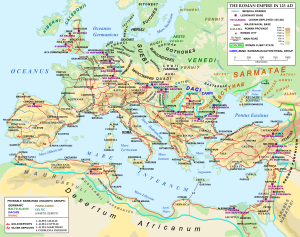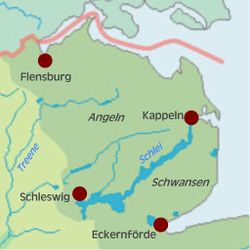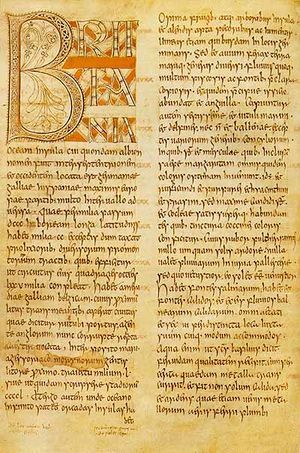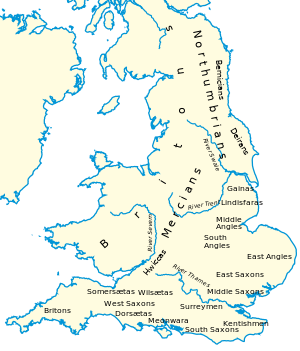أنگل

الأنجلز واحدة من ثلاث قبائل جرمانية غزت بريطانيا خلال القرنين الخامس والسادس الميلاديين. والقبيلتان الأخريان هما الجوت والسكسون، اللتان تنتمي إليهما الأنجلز بقرابة حميمة. أنشأ الغزاة ممالك صغيرة، استمر بعضها حتى الفتح النورمندي عام 1066م.
أتى الأنجلز إما من أنجلن، وهي مقاطعة فيما يعرف الآن بشلسڤيگ-هولشتاين، أو من الدنمارك. وقد بدأوا وقتها في التحول إلى المرحلة الزراعية من الحضارة، عندما وصلوا إلى إنجلترا وهزموا البريتونيين الذين كانوا يقطنون على امتداد الساحل الشرقي، وأنشأوا ممالك نورثمبريا وميرسيا وإيست أنجيليا فيما يعرف الآن بشمالي وشرقي ووسط إنجلترا. وكانت هذه الأقاليم تعرف بأنجل لاند؛ أي أرض الأنجل، والتي أتى منها اسم إنجلترا.
أصل الكلمة
الاسم العرقي "أنگل Angle" أخذ عدة أشكال وهجاءات، أقدم ما وصلنا الاسم الملتن Anglii، وهي قبيلة جرمانية مذكورة في كتاب تاكيتوس جرمانيا.
التاريخ المبكر
الإنگلز بأسماء أخرى
جغرافيان هامان، سطرابون وپليني، لم يذكرا الأنگلز. Their reasons for this exclusion was their consideration of the south shore of the Baltic to be terra incognita, "unknown land." However, both Strabo and Pliny describe that shore. Since the Angles took a geographic name, they likely had other names not based on geography.
Strabo's mention of the معركة غابة تويتوبورگ places his knowledge in the final years of Augustus' reign and after, which is the early first century. Strabo (7.2.1, 4 and 7.3.1) states that the Cimbri still live on the peninsula (Jutland) where they always did, even though some of them liked to wander. Beyond the Elbe the coastal people are unknown in Strabo's work, but south of them are the Suebi from the Elbe to the Getae (Goths). Strabo worked eastward from the Rhine.
Pliny, on the other hand, worked from east to west (4.13.94). His description leaves the Black Sea, crosses the Ripaei mountains to the shore of the northern ocean, and follows it westward to Cadiz. In the first direction is Scythia, where the Sarmati, Venedi, Sciri, and Hirri are located, as far as the Vistula. Then the Inguaeones begin. Baunonia (Bornholm) is an island opposite Scythia. Cylipenus, probably the Bay of Kiel, is described, and from there a gulf called Lagnus, which is on the frontier of the Cimbri. Its location is not known, but it was likely in the Angeln region.
In Pliny, the Inguaeones consisted of the Cimbri and the Teutones (the Chauci as well, but they were not in this region). If Lagnus was situated on the Cimbrian frontier and after Kiel, then Angeln must have been in the territory of the Teutones. They were perhaps not named "Angles" at that time; however, the territory of the Teutones probably included the Vorpommern and the region south to the Elbe (mainly Holstein), accounting for the implied larger range of the Angles in later sources.
تاكيتوس
بـِده
الممالك الأنگلية في إنگلترة
انظر أيضاً
- الشعوب الجرمانية
- قائمة الشعوب الجرمانية
- For the rulers of the Angles prior to their migration to Great Britain, see قائمة ملوك الأنگلز
- Thorsberg moor
المصادر
الهامش
وصلات خارجية
- English and Welsh are races apart; BBC; 30 June 2002.
- British Islanders come mainly from Spain; Prospect Magazine; 18 November 2006.


